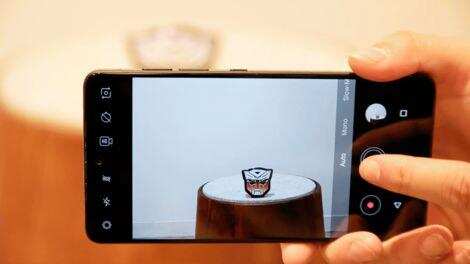Updated with more details on Samsung's trade-in program for Galaxy Note 7 owners.
There's a lot riding on the Samsung Galaxy Note 8's glossy, curved shoulders, two rear cameras and digital S Pen stylus.
The Galaxy Note 8 has to wash away the bad taste of last year's battery-burning Note 7 double-recall. It has to outshoot every other phone with a set of dual cameras that's already out there. And finally, Samsung's highest-end phone needs to outshine the LG V30, Google Pixel 2 and iPhone 8, while also convincing buyers to choose it over the cheaper Galaxy S8 and Galaxy S8 Plus.
See what I mean? Tough work.
From what I've seen of the Note 8 so far, it stands a fighting chance at doing all three. The phone itself satisfies all the requirements of today's modern, high-powered handset, with its bright, 6.3-inch screen, twin rear cameras with portrait mode, a top-of-the-line-process or, wireless charging and water resistance. There's also external storage and its S Pen stylus has a handful of new tricks you can use to write, draw and navigate the screen. And did I mention the headset jack? There's one of those, too. (Nudge, nudge, iPhone 7.)
As the first new, (hopefully) safe Note since the Note 5 in 2015 -- remember, Samsung skipped the Note 6 name in favor of the Note 7 -- you'd expect the Note 8 to go big, silencing the naysayers and rewarding the fans. After all, Note buyers are the Samsung's biggest mobile cheerleaders, "the most energetic, engaged, loyal consumers," according to Justin Denison, a senior VP of product marketing and strategy at Samsung.
Instead of splashing out, though, Samsung played it safe. The Note 8's battery is smaller than 2016's model, in part to keep from repeating last year's fatal mistake.
There are also a lot of carry-overs from the Galaxy Note 7 and Galaxy S8 that keep the Note 8 from feeling truly fresh. F or example, the S Pen stylus only adds a few more tricks, none of which will set off industry shockwaves. (They're still fun, though. More on that below.) And then there's the awkward placement of that fingerprint sensor. Sorry, rumor junkies, it hasn't moved under the screen after all. Why Samsung chose to replicate the worst design shortfall of its earlier phone is beyond me; the Note 8 is a large phone that'll have you stretching for the sensor. Or else you'll give up and use a different way to unlock the phone and green-light Samsung Pay.
The twin rear cameras are the only major feature that's truly new, and they're a first for any Samsung phone. But dual cameras are now so common in high-end handsets that they've quickly become the norm. Samsung's implementation, however, is really promising, and it takes Apple's Portrait Mode to the next level. That's tentatively a notch in Samsung's belt. (And again, much more on this below.)
I can't wait to fully test the Galaxy Note 8's new twin cameras, battery life and hidden tricks. At first glance, it's an attractive, fully featured device for power users who are looking for the ultimate in handheld computing. In a lot of ways, the Note 8 is the Galaxy Note 7 we should have had, but with a modern camera experience that promises something extra.
The S Pen stylus is a drawing machine.
Andrew Hoyle/CNET
There's just one final sticking point, and that's price. The Note series is typically Samsung's costliest phone, an expense that Samsung justifies with the most cutting-edge features and a heap of stylus tricks. This could work in Samsung's favor if the iPhone 8, Google Pixel 2 and LG V30 also cost a bundle. Or, the relatively high price could backfire if more buyers go for the Galaxy S8 Plus instead. Sure, the S8 Plus has only one rear camera and no stylus, but it's otherwise about the same, for a little less cash.
Read on for a breakdown of the Galaxy Note 8's specs, and photo-taking capabilities and S Pen features. For a full comparison with today's top phones, skip to the end.
And remember, our final verdict on whether the Note 8 is worth the price will come after we've received a review unit and had a chance to fully test the phone.
Note 8 price and when to buy
Absolutely excellent news for original Note 7 owners: Samsung will grant a discount on the Note 8 as an apology for the hassle of having returned your last phone. The big catch? This is currently for US customers only. It's a good start, and one we hope Samsung will extend to other affected buyers worldwide.
Note 7 owners who go to Samsung.com will receive an instant trade-in value of up to $425 (about £330 or $AU540) when you upgrade your current phone for a Galaxy Note 8. It's gratifying to see Samsung make good with 2016's endangered, inconvenienced buyers. Moreover, it's the final step Samsung needed to take to finally put the Note 7 disaster to rest.
Preorders start Aug. 24, and the phone goes on sale Sept. 15 in the US, UK, South Korea and other select countries. It'll roll out globally through October.
You'll be able to buy the phone through carriers, Samsung.com and other retailers. Samsung is also doing something different and immediately selling the Galaxy Note 8 unlocked rather than waiting we eks or months to offer an unlocked option.
In Australia, it costs AU$1,499. Preorders start 25 August from selected retailers.
Is the Note 8 battery safe?
If you were burned by the Galaxy Note 7 flame-out, you might be a little gunshy about the Note 8.
Here's what Samsung's done to help cool your fears:
Instituted an 8-point battery safety checkReduced battery size and capacity from 3,500mAh to 3,300mAh to leave more room in the phone's cavityPartnered with UL, a certification company, to endorse the Note 8Of course, we won't know for certain if any phone battery is faulty until users' reports come in. For the record, there have not been similar widespread reports of problems with the Galaxy S8 and S8 Plus batteries. However, if you're wary, it doesn't hurt to watch and wait.
Upping the dual-camera ante
Samsung's first two-camera setup places a 12-megapixel telephoto lens alongside a 12-megapixel wide-angle lens (there's also an 8-megapixel camera up front). Both cameras use optical image stabilization (OIS) to help keep images and video looking smooth.
Those two cameras on the back aren't just for show.
Josh Miller/CNET
Portrait mode is the major use case here. This applies a softly blurred background around the subject (which itself is in focus), like an aura of mystique that makes the person or thing pop out.
Samsung calls it Live Focus, and it lets you do more than you can on other phones with similar modes, including the iPhone 7 Plus ($1,269.00 at Apple), which popularized the feature.
You can adjust the amount of blur on a sliding scale of 0-10 before you take the shotIt lets you use both lenses to take and save two pictures in the gallery. One photo is the blurry portrait (this is also called bokeh effect), and one that's a wider-angle image that keeps the background in focus, and more of it in the frame. The iPhone 7 Plus does something similar, except its second non-bokeh image saves at the same aspect ratio as the bokeh one.It's called Dual Capture, and although it's automatic, you can turn it off in the se ttings.You can also remove or alter the blur effect from the gallery after you take a picture.You can pop between the portrait and full photo.Other camera details for shutterbugs: 2x optical zoom, up to 10x digital zoom, F2.4 telephoto lens, F1.7 wide-angle lens with dual-pixel auto-focus.
Galaxy Note 8's best new features
You won't see these on the Galaxy S8, or any other phone for that matter.
Live Message
This creates an animated GIF of a handwritten note, which is written back in real time. You can add photo backgrounds to create your own personal meme. What stands out here is that you can share these on any app that supports animated GIFs, so Facebook Messenger, for example, or WhatsApp.
On the Note 8, you can create a Live Message from the Air Command navigation wheel (which you see when you pull the S Pen from its holster) and from the keyboard, if you hold down the custom key and find the Live Message option.
Write on the lock screen
Screen-off Memo was introduced on the Note 7. It lets you scribble on the screen without having to unlock the phone, and it's pretty great. You can pin a note to the always-on display, and now you can save it and pin again to lengthen the list and create up to 100 pages. You can still transcribe pages if you save them to your Notes app.
Next-level split-screen multitasking
If you find yourself constantly using the same two apps in split screen mode, the Note 8 gives you an option to link them together and open them both with a tap. Say, for example, YouTube and your internet browser, or Google Maps and music.
It's called App Pair. You start by pulling out the tab on the edge of the screen, and swipe to get to the app shortcuts. Samsung says it will start you off with one or two pairings, but you can also link your own apps in settings. Then when you're ready to use them, a tap on the app pair icon loads them both in split screen mode.
Full-sentence transl ation and currency conversion
You used to have to translate in foreign languages a word at a time -- say by selecting words on a foreign-language website with the S Pen. But now you can click an entire sentence and translate it all at once. The expanded feature works for over 70 languages and uses Google Translate. The tool also converts currency.
What else?
6.3-inch AMOLED screen with 2,960x1,440-pixel resolutionSlim bezels, curved sides, aluminum and glass buildBixby button lives on the phone's left side, with Bixby Voice software ready at launch -- it was delayed on the Galaxy S8, but it's now available in select regionsThe fingerprint reader is on the phone's back to the far side of the dual-camera array. This is a tall phone, so you might fumble and stretch for itThe S Pen tip is 0.7 mm, same as on the Note 7, and it's still got 4,096 levels of pressure sensitivityBoth the phone and S Pen are water-resistant (IP68)C olors: Deepsea blue, maple gold, midnight black, orchid gray (not all colors are available in all regions)See full Note 8 specs below.
Samsung Galaxy Note 8 Samsung Galaxy S8 Plus Apple iPhone 7 Plus OnePlus 5 Display size, resolution 6.3-inch; 2,960x1,440 pixels 6.2-inch; 2960x1440 pixels 5.5-inch; 1,920x1,080 pixels 5.5-inch; 1,920x1,080 pixels Pixel density 522ppi 529ppi 401ppi 401ppi Dimensions (Inches) 6.4x2.9x0.34 in 6.3x2.9x0.32 in 6.2x 3.1x0.29 in 6.1x2.92x0.29 in Dimensions (Millimeters) 162.5x74.8x8.6 mm 159.5x73.4x8.1 mm 158.2x77.9x7.3 mm 154.2x74.1x7.3 mm Weight (Ounces, Grams) 6.9 oz, 195g 6.1 oz; 173g 6.63 oz; 188g 5.4 oz; 153g Mobile software Android 7.1.1 Nougat Android 7.0 Nougat Apple iOS 10 Android 7.1.1 Nougat Camera Dual 12-megapixel 12-megapixel 12-megapixel (telephoto), 12-megapixel (wide) 16-megapixel standard, 20-megapixel telephoto Front-facing camera 8-megapixel 8-megapixel 7-megapixel 16-megapixel Video capture 4K 4K 4K 4K Processor Octa-core Qualcomm Snapdragon 835 (2.35GHz+1.9GHz) or octa-core Samsung Exynos 8895 (2.35GHz+1.7GHz) Octa-core Qualcomm Snapdragon 835 (2.35GHz+1.9GHz) or octa-core Samsung Exynos 8895 (2.35GHz+1.7GHz) Apple A10 chip (64-bit) 2.45GHz Qualcomm Snapdragon 835 Storage 64GB 64GB 32GB, 128GB, 256GB 64GB, 128GB RAM 6GB 4GB N/A 6GB, 8GB Expandable storage Up to 2TB Up to 2TB None None Battery 3,300mAh 3,500mAh 21 hours talk time on 3G, 16 days standby, 13 hours internet use LTE 3,300mAh Fingerprint sensor Back cover Back cover Home button Home button Connector USB-C USB-C Lightning USB-C Special features S Pen stylus, water-resistant, wireless charging Water-resistant (IP68), wireless charging, Gigabit LTE-ready Water and dust-resistant; portrait image mode Portrait mode, notifications toggle, dual-SIM, Dash Charging Price off-contract (USD) AT&T: $950; Verizon: $960; T-Mobile: $930; Sprint: $960; US Cellular: $963 AT&T: $850; Verizon: $840; T-Mobile: $850; Sprint: $850; US Cellular: $785 $769 (32GB); $869 (128GB); $969 (256GB) $479 (64GB), $539 (128GB) Price (GBP) £869 £779 £719 (32GB); £819 (128GB); £919 (256GB) £449 (64GB), £499 (128GB) Price (AUD) AU$1,499 AU$1,349 AU$1269 (32GB); AU$1419 (128GB); AU$1569 (256GB) Converts to AU$636 (64GB), AU$715 (128GB)
Source:
Shiny Galaxy Note 8 gets dual cameras, but plays it safe
 It's too soon to write off our smartphones as boring.The gadgets are still evolving with new technologies. And for a clue as to what the smartphone of the future might look like, turn your attention to the device's cameras and the software and sensors that make them tick.
It's too soon to write off our smartphones as boring.The gadgets are still evolving with new technologies. And for a clue as to what the smartphone of the future might look like, turn your attention to the device's cameras and the software and sensors that make them tick. 13999
13999






 Sameer Mitha sameer.mitha@digit.in
Sameer Mitha sameer.mitha@digit.in 













